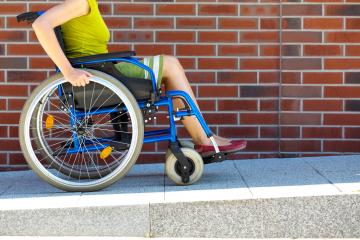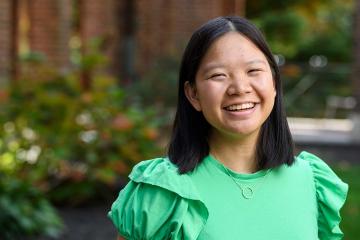As Johns Hopkins University's first-ever director of disability, culture, and inclusion, Nathan R. Stenberg has been tasked with developing a universitywide vision for disability.
"It is incredibly awe-inspiring," Stenberg said of his new role in JHU's Office of Diversity and Inclusion, which he joined this past fall. "And also anxiety-inducing," he added with a laugh.
Image caption: Nathan R. Stenberg stands outside Mason Hall on Johns Hopkins University's Homewood campus
Image credit: Will Kirk / Johns Hopkins University
With years of both personal and professional experience to draw from, Stenberg is up for the challenge. He is a first-generation, developmentally disabled college graduate from a low-income, single-parent family in rural Minnesota; he has spent much of his career advocating for the disability community through public speaking, policy work, research, consulting, and the performing arts. Additionally, he serves on the steering committee for the proposed National Museum of Disability History & Culture and on the board of directors for the Pennhurst Memorial and Preservation Alliance, a disability rights advocacy group.
The Hub sat down with Stenberg to learn more about how his newly created role will drive meaningful change at Johns Hopkins.
What drew you to Hopkins?
This position is not only a first for the institution; it's a first in a lot of ways beyond Hopkins. Twenty-seven percent of Americans identify as disabled. And yet, unfortunately, not a lot of opportunities exist for people with disabilities, especially senior leadership roles. From my perspective, the apparentness of disabled people in leadership is key.
From elementary school up until I completed my PhD, I never had an openly disabled faculty member, mentor, or anyone that I could look to and say, "Oh, they share my experience." That is one of the reasons why mentorship is really important to me. I am excited to work with disabled students, faculty, and staff, not only to show that we exist but also to push our community forward.
What are some of the challenges you anticipate in your role?
Making sure we are all on the same page will be the ultimate challenge—how do we create a more unified, centralized vision for disability at Hopkins while ensuring that each division keeps its autonomy? How do we do that while working in tandem?
Broadly speaking, in the 30 years since disability rights entered the national conversation, the disability community has remained concerned about rights, accommodations, and anti-discrimination. As someone who has experienced discrimination in the past, I am very grateful for the protections I have. Pieces of legislation, like the Americans with Disabilities Act, the Developmental Disabilities Assistance and Bill of Rights Act, and the Individuals with Disabilities Education Act, provided me with the opportunity for an education. Without them, I would have likely been put in an institution. That said, it is essential to consider what is next. How do we move past accommodations and discrimination, for example?
How do you view your role in facilitating the mission of the Office of Diversity and Inclusion?
I see myself as a convener and collaborator. One thing I have learned throughout my life and professional career is that listening matters. I am actively trying to go out and meet people in person and not just be some faceless name in an email chain. I am trying to understand not only this broad Hopkins community but also get to know the amazing people who are already doing the work to champion disability on campus. Hopkins is a decentralized institution, and that comes with both opportunities and challenges. What I am doing is bringing people together, collaborating, and thinking about the processes in place—how can this office champion the powerful work that is already being done, and then take that learning and leverage it for something even broader?
What kind of experience do you bring to the role?
I have not only worn many hats but lovingly lived in them. I guess that is the joy of growing up in rural Minnesota. I have worked as a farmhand and a landscaper, I have picked up trash for my county fair, and I have worked at a bunch of different restaurants. However, I have also trained as a musician, sound engineer, and personal trainer. After I went to grad school, I homed in on public speaking and consultant work, using the performance training I received through both waiting tables and being on stage. The transition just made sense. Through public speaking and, most recently, filmmaking, I strive to make my research more public-facing. I did not think anyone was going to read my dissertation, so I figured out how I could take it and translate it for a broader audience. Prior to coming to Hopkins, I was working in Washington, D.C., in the area of disability policy, specifically trying to think about what that looks like beyond Home- and Community-Based Services (HCBS), Section 504 of the Rehabilitation Act, the Americans with Disabilities Act, and other bread-and-butter disability policies and legislation.
What kind of research do you do?
I am interested in policy, law, medical history, and critical disability studies, but my primary academic discipline is performance studies. Currently, my research is focused on a former state institution for disabled people in Pennsylvania—the Pennhurst State School & Hospital—that was closed after a long litigation battle that involved two separate appeals to the U.S. Supreme Court. After Pennhurst closed in 1987, and the commonwealth placed the former inmates into the community, the institution sat dormant for 20 years and fell into disrepair. In 2008, it was privately purchased and turned into a for-profit haunted house that primarily staffs disabled people.
With Pennhurst, my main research question centers on how this former institution became a performance venue that commodifies violence for entertainment, while paradoxically fostering community for the very people the former institution sought to eliminate. In turn, Pennhurst teaches us about our contemporary policies of care. What I found is that the historical and ongoing process of institutionalization constructs and enforces legal, medical, political, and social notions of disability that produced, and continue to produce, identities that simultaneously dehumanize and sustain disabled people. Institutionalization, then, is not just this thing that happened in bygone eras; it is an ongoing social process. The haunted house at Pennhurst highlights how one disabled community uses performance to reinterpret and reclaim it.
What are some things that Hopkins is already doing to be more inclusive?
For one, creating this role, and just the fact that I am sitting here having this conversation with you. That within itself is something. When I was applying to this job, I went back and read a lot of the school's diversity materials, like JHU's first and second Roadmaps on Diversity, Equity, and Inclusion. I saw that Hopkins had a real reckoning with how to make the disability community, along with other underserved groups, feel valued here, recognizing it had not been living up to its stated values. It was powerful motivation to work here seeing the institution be self-critical and make such a strong declaration of support toward a variety of different underserved communities and experiences. Hopkins is putting money where their mouth is. That is incredible. We get to dream big. So let us do the work; together, we can become the global leader in disability equity, innovation, and culture.
Posted in Community
Tagged diversity, disability










